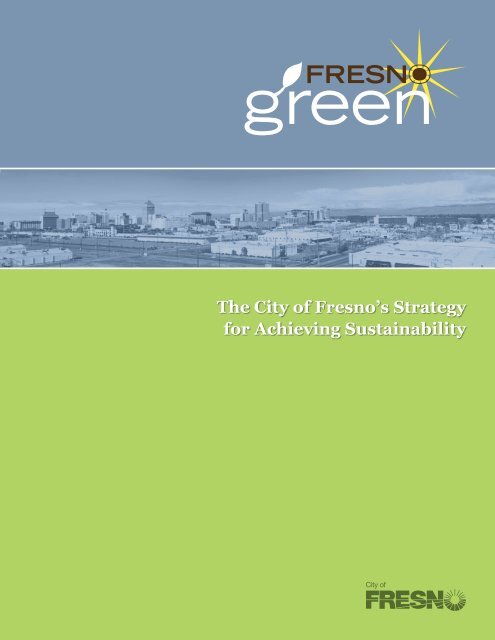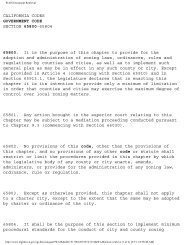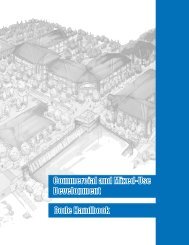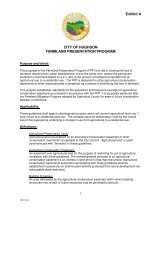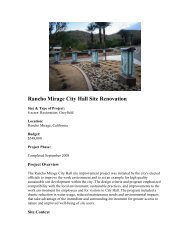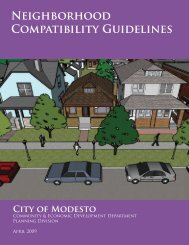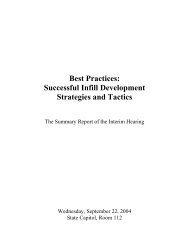The City of Fresno’s Strategy for Achieving Sustainability
Fresno Green - Tufts University
Fresno Green - Tufts University
Create successful ePaper yourself
Turn your PDF publications into a flip-book with our unique Google optimized e-Paper software.
<strong>The</strong> <strong>City</strong> <strong>of</strong> <strong>Fresno’s</strong> <strong>Strategy</strong><br />
<strong>for</strong> <strong>Achieving</strong> <strong>Sustainability</strong>
green:<br />
being a good steward <strong>of</strong> the earth’s natural resources.<br />
• Protects urban <strong>for</strong>ests<br />
• Promotes smart growth<br />
• Buys locally<br />
A green city is one that:<br />
• Harnesses solar energy<br />
• Provides bike and pedestrian trails<br />
• Leads by example<br />
• Rethink, Reduce, Reuse, Recycle!<br />
Why ‘Fresno Green’?<br />
It is hardly a secret that the San Joaquin Valley’s air<br />
is some <strong>of</strong> the dirtiest in the United States, and that<br />
our children experience a high rate <strong>of</strong> asthma. On a<br />
more global scale, we are quickly depleting our source<br />
<strong>of</strong> fossil fuels, our landfills are overflowing, fresh water<br />
is becoming increasingly scarce, and other natural resources<br />
are pushed to the brink.<br />
Being “green” – that is being environmentally responsible<br />
– Is no longer just a fad and technologically cool,<br />
it is imperative.<br />
To quote a Lakota Sioux proverb:<br />
“We do not inherit the earth<br />
from our ancestors; we borrow<br />
it from our children.”<br />
Imagine being able to see the Sierras from the valley<br />
every day, bicycling or walking to work, preserving<br />
more open space as well as our Valley’s agricultural<br />
heritage. Imagine living in a city that mixes the best <strong>of</strong><br />
the old with the new.<br />
<strong>The</strong>se are some <strong>of</strong> the visions <strong>of</strong> Fresno Green.<br />
Green/sustainable programs combine cutting edge<br />
technology with the best common sense practices <strong>of</strong><br />
the past.<br />
PHOTO BY KEITH SEAMAN | CAMERAD<br />
Fresno Green embraces the heritage <strong>of</strong> the “<strong>City</strong><br />
Beautiful Movement” <strong>of</strong> the early 20th century—progressive<br />
urban design, expansive parks and open<br />
space, public health and public art programs… Fresno<br />
Green moves us toward a New <strong>City</strong> Beautiful.<br />
<br />
FRESNO GREEN<br />
FRESNO GREEN
<strong>The</strong> objective <strong>of</strong> FRESNO GREEN is clear and unchanging:<br />
Fresno will be a sustainable city by 2025.<br />
Preface<br />
Through the leadership <strong>of</strong> Mayor Autry and the <strong>City</strong><br />
Council, the <strong>City</strong> adopted the 2025 Fresno General Plan<br />
in November, 2002. This Plan dramatically changed the<br />
patterns <strong>of</strong> growth in Fresno, focusing development “inand-up”<br />
rather than continuing an outward expansion<br />
beyond the city’s planned urban boundary.<br />
<strong>The</strong> General Plan substantially enhances the established<br />
community’s physical and social environment<br />
through revitalization <strong>of</strong> <strong>Fresno’s</strong> existing urban core.<br />
<strong>The</strong> Plan promotes conservation <strong>of</strong> significant natural,<br />
physical, historical and cultural resources. <strong>The</strong> General<br />
Plan is working as evidenced by growth patterns over<br />
the past five years.<br />
<strong>The</strong> strategies and tactics <strong>for</strong> achieving this objective are intended to be<br />
periodically reviewed and updated as we move toward the objective.<br />
<strong>The</strong> next step is the progression <strong>of</strong> Fresno into a sustainable<br />
city, a community that meets the needs <strong>of</strong> the<br />
present without compromising the ability <strong>of</strong> future generations<br />
to meet their own needs. <strong>The</strong> foundation <strong>of</strong><br />
sustainability is good stewardship <strong>of</strong> the earth’s natural<br />
resources. Clear views <strong>of</strong> the Sierra Nevada, extensive<br />
open space and pathways, encouragement <strong>of</strong> local<br />
agricultural producers, innovative solar technology, a<br />
healthy urban <strong>for</strong>est and zero landfill waste are all indicators<br />
<strong>of</strong> a sustainable community.<br />
Sustainable development balances economic development<br />
and environmental stewardship with innovative<br />
business enterprises that focus on the “triple bottom<br />
line” <strong>of</strong> providing economic, environmental and social<br />
benefits. In early 2007, Mayor Autry, together with<br />
then Council President Henry T. Perea, asked the <strong>City</strong><br />
Manager and the One Fresno Key Results Area (KRA)<br />
Cabinet to develop a Green Element to support the<br />
2025 Fresno General Plan.<br />
Fresno Green: the <strong>City</strong> <strong>of</strong> <strong>Fresno’s</strong> <strong>Strategy</strong> <strong>for</strong><br />
<strong>Achieving</strong> <strong>Sustainability</strong> is an action-oriented plan that<br />
will trans<strong>for</strong>m Fresno into a sustainable city. Fresno<br />
Green consists <strong>of</strong> 25 strategies with accompanying<br />
implementation tactics.<br />
Progress has already<br />
been made.<br />
• <strong>The</strong> <strong>City</strong>’s vehicle and bus fleets are converting to clean fuels.<br />
• Land use policies encourage walkable mixed use neighborhoods.<br />
• Solar panels are sprouting <strong>of</strong>f the tops <strong>of</strong> residential and commercial<br />
buildings as well as at the Municipal Service Center and<br />
Fresno Yosemite International Airport.<br />
• <strong>The</strong> <strong>City</strong>’s Team Clean Air initiative is a progressive program designed<br />
to reduce air polluting emissions through <strong>City</strong> operations.<br />
• Operation Clean Air, initiated by Mayor Autry, is a regional collaborative<br />
focused on improving air quality.<br />
• <strong>The</strong> Public Utilities Department has been honored<br />
nationally <strong>for</strong> energy conservation.<br />
• <strong>The</strong> Public Works Department is completing a significant<br />
portion <strong>of</strong> a city-wide traffic synchronization project that will<br />
reduce vehicle emissions.<br />
• <strong>The</strong> Parks, recreation and Community Services Department continues<br />
to partner with the San Joaquin River and Conservation Trust to<br />
develop a 23-mile, 6000 acre green belt with recreational trails.<br />
• Interest in a sustainable future was furthered by <strong>City</strong> Council action in<br />
February 2004 through the ef<strong>for</strong>ts <strong>of</strong> current Council President, Henry T.<br />
Perea. His proposal to explore sustainable building development<br />
resulted in the Planning and Development Department convening a task<br />
<strong>for</strong>ce <strong>of</strong> <strong>City</strong> employees and private sector members to develop an<br />
incentive-based Fresno Green building program.<br />
• <strong>The</strong> Mayor’s Creative Economy Council Report <strong>of</strong> 2006 targeted<br />
sustainability and energy efficiency as major community goals.<br />
Fresno Green<br />
Team Partners<br />
with Fresno State<br />
SOLAR ARRAY PARKING<br />
STRUCTURE AT FRESNO STATE.<br />
On March 25th 2008, Fresno<br />
<strong>City</strong> Council presented a<br />
joint proclamation with<br />
Cali<strong>for</strong>nia State University<br />
President John D. Welty,<br />
declaring a partnership<br />
to be know as Univer/<strong>City</strong><br />
Sustainable Initiative.<br />
<strong>The</strong> Fresno Green Team<br />
is in full partnership with<br />
Fresno State’s <strong>Sustainability</strong><br />
Team to assist in the greening<br />
<strong>of</strong> the entire <strong>City</strong>. Both<br />
the University and the <strong>City</strong><br />
will benefit from the shared<br />
resources and technical<br />
expertise, as we proceed toward<br />
the implementation <strong>of</strong><br />
the Fresno Green Strategies.<br />
<br />
FRESNO GREEN<br />
FRESNO GREEN
Ready to plant the seeds<br />
<strong>The</strong> field is plowed and the <strong>City</strong> is ready to plant the<br />
seeds <strong>of</strong> a more thorough, multifaceted and unified approach<br />
to growing a green city. <strong>The</strong> purpose <strong>of</strong> Fresno<br />
Green is to provide the framework <strong>of</strong> this approach.<br />
<strong>The</strong> strategies and tactics <strong>of</strong> Fresno Green will aim<br />
to reduce consumption <strong>of</strong> non-renewable resources,<br />
improve air quality, position Fresno as a leader in solar<br />
energy and other green enterprises, reduce waste generation,<br />
and honor our agricultural heritage as we build<br />
the future.<br />
Fresno Green is organized into five visions:<br />
<br />
NEw city<br />
bEautiFul<br />
FRESNO GREEN<br />
siERRa ViEw<br />
2025<br />
solaR<br />
VallEy<br />
Progress toward Fresno Green occurs in two arenas:<br />
1) the community at large (the private sector)<br />
2) the public sector.<br />
We believe that in order to encourage a communitywide<br />
trans<strong>for</strong>mation the <strong>City</strong> <strong>of</strong> Fresno needs to “walkthe-talk”<br />
and take bold action.<br />
GREEN<br />
ENtERPRisEs<br />
aND<br />
EcoNoMic<br />
DEVElPMENt<br />
city as<br />
GooD<br />
stEwaRD<br />
<strong>The</strong> strategies listed in the first four areas are generally private-sector oriented, supported by <strong>City</strong> <strong>of</strong> Fresno programs<br />
in Section 5, “<strong>City</strong> as Good Steward.” However, some public sector <strong>City</strong> policies appear in other sections; the<br />
topics <strong>of</strong> air quality and energy conservation inevitably overlap, which means a variety <strong>of</strong> strategies can be accomplished<br />
with a few well-chosen and concerted actions.<br />
Finally, Fresno Green is intended to be a bridge. Working together, we can <strong>for</strong>ge the public-private partnerships<br />
needed to accomplish the objective. Continuing this metaphor, we can then cross the bridge to a more sustainable<br />
future by refining our strategies and tactics into an innovative element <strong>of</strong> the <strong>City</strong>’s General Plan. Finally, through<br />
partnerships we will elevate and deepen our commitment to the triple bottom line <strong>of</strong> economic, environmental and<br />
social sustainability.<br />
We invite all to join us in crossing the bridge into a more sustainable future.<br />
Fresno Green visions:<br />
New <strong>City</strong> Beautiful<br />
Fresno will be nationally recognized <strong>for</strong> the innovative integration <strong>of</strong> buildings within their neighborhood<br />
context, good urban design, and <strong>for</strong> giving priority to public health, open spaces, public art, historic preservation,<br />
urban <strong>for</strong>ests and the protection <strong>of</strong> natural habitats.<br />
Sierra View 2025<br />
<strong>The</strong> Sierra Nevada mountain range will be clearly visible to all Valley residents by 2025. Public health<br />
will be improved by having cleaner air, enhanced public transportation and additional opportunities <strong>for</strong><br />
walking and cycling.<br />
Solar Valley<br />
Fresno will become a leader in renewable energy use by maximizing new renewable sources as well as<br />
increasing the efficiency <strong>of</strong> our existing uses. Fresno will lead the state in the creation <strong>of</strong> related innovative<br />
technology and new business enterprises. With its abundant sunshine and population growth, the opportunity<br />
exists to improve air quality, reduce dependence on <strong>for</strong>eign energy, and provide attractive new jobs<br />
by harnessing solar and other types <strong>of</strong> renewable energy.<br />
Green Enterprises and Economic Development<br />
<strong>The</strong> <strong>City</strong> <strong>of</strong> Fresno will become a center <strong>for</strong> innovative business enterprises that focus on the “triple<br />
bottom line” <strong>of</strong> providing environmental, economic and social benefits.<br />
<strong>City</strong> as Good Steward<br />
<strong>The</strong> <strong>City</strong> <strong>of</strong> Fresno will lead by example by greening up its facilities and practices, embracing a zero waste<br />
initiative, providing appropriate staff resources, and collaborating with other municipalities and agencies<br />
to develop regionally-based Green programs.<br />
<strong>Sustainability</strong> is:<br />
“…development that meets the needs <strong>of</strong> the present<br />
without compromising the ability <strong>of</strong> future generations<br />
to meet their own needs”<br />
World Commission on the Environment and Development<br />
FRESNO GREEN
New <strong>City</strong> Beautiful<br />
Green Buildings and Sustainable Development, Public Health, Open Spaces<br />
<strong>Strategy</strong> 1<br />
Develop and implement new urbanist principles that advance higher<br />
density, mixed use, and accessible neighborhoods which coordinate<br />
land use and transportation with open<br />
space systems <strong>for</strong> recreation and ecological<br />
restoration by 2011. Develop<br />
and implement Green building<br />
standards <strong>for</strong> private residential,<br />
multi-family and commercial<br />
projects 2011.<br />
<strong>Strategy</strong> 2<br />
Build all new municipal buildings according to a green building rating system. Adopt green technology <strong>for</strong> the retr<strong>of</strong>it<br />
<strong>of</strong> existing <strong>City</strong> buildings by 2011.<br />
Make public buildings didactic through the development <strong>of</strong> permanent interpretive panels at each<br />
site that “teach” about the building’s use <strong>of</strong> green technology by 2011.<br />
Require all construction wastes generated from new construction and demolition to be recycled, beginning in 2008.<br />
<strong>Strategy</strong> 3<br />
Plan new residential areas and retr<strong>of</strong>it existing neighborhoods to be within one half mile <strong>of</strong> public parks, school<br />
playgrounds and/or recreational open space by 2011.<br />
Refine the <strong>City</strong>’s 2007 draft Open Space Policy in order to meet this strategy by 2010.<br />
Revise the <strong>City</strong>’s Parks’ Master Plan to meet this strategy by 2010.<br />
<strong>Strategy</strong> 4<br />
Plant and maintain trees in order to achieve shading <strong>of</strong> at least 50% <strong>of</strong> all<br />
hardscaped parking and pedestrian surfaces by 2015.<br />
HENRY MADDEN LIBRARY CONSTRUCTION | 85% RECYCLING OF CONSTRUCTION WASTES<br />
Finalize Planning Department’s incentive-based green building program which links sustainable building and<br />
communities, historic preservation, public art and historic landscapes into a holistic approach by 2009.<br />
Build at least 20% <strong>of</strong> all future <strong>City</strong>-sponsored af<strong>for</strong>dable housing units to meet an adopted<br />
Green building standard, beginning in 2011.<br />
Update general plan and zoning code to promote increased densities around activity centers and transportation<br />
corridors, and to encourage trip reduction through mixed use development by 2011.<br />
Update subdivision design standards to promote vehicular and pedestrian Connectivity by 2011.<br />
Update street design standards to provide increased quality <strong>of</strong> life <strong>for</strong> residential neighborhoods, a more<br />
attractive bike and pedestrian environment, and conservation <strong>of</strong> natural resources by 2012.<br />
Adopt revised zoning ordinances and building codes that are consistent with the Fresno Green<br />
incentive program by 2010.<br />
<br />
FRESNO GREEN<br />
Work with community groups such as Tree Fresno to conduct an inventory <strong>of</strong> existing canopy coverage in the<br />
city and to prepare adequate maintenance plans <strong>of</strong> <strong>City</strong>-owned trees and landscaped medians by 2010.<br />
Develop Alternate Public Improvement Standards (API) that protect <strong>Fresno’s</strong> historic landscapes, such<br />
as Kearney Boulevard by 2010.<br />
<strong>Strategy</strong> 5<br />
Through implementation <strong>of</strong> the Regional Cooperation Element <strong>of</strong> the 2025 Plan, protect critical habitat corridors<br />
and other key habitat characteristics (e.g. water features, food bearing plants, shelter <strong>for</strong> wildlife, use <strong>of</strong> native species,<br />
etc.) from unsuitable development by 2015.<br />
Work with regional partners to develop an agricultural land conservancy program. Apply new agricultural land<br />
preservation and conservancy programs both within and outside <strong>of</strong> the <strong>City</strong>’s Sphere <strong>of</strong> Influence (SOI) by 2015.<br />
Provide incentives <strong>for</strong> habitat restoration and protection through the <strong>City</strong>’s Fresno Green<br />
building incentive program by 2011.<br />
Partner with the San Joaquin River Parkway and Conservation Trust to maintain and operate<br />
accessible areas along the SJR Parkway by 2009.<br />
<br />
FRESNO GREEN
<strong>Strategy</strong> 6<br />
Reduce the use <strong>of</strong> disposable toxic or non-renewable products through<br />
environmentally preferred purchasing policies, by 2009.<br />
Support a residential hazardous waste facility in cooperation<br />
with Fresno County.<br />
Support Producer Responsibility, where product<br />
manufacturers are responsible <strong>for</strong> the final disposal <strong>of</strong> any<br />
toxic products produced, through continued support <strong>of</strong> the<br />
Cali<strong>for</strong>nia Product Stewardship Council.<br />
Reduce use and sale <strong>of</strong> non-rechargeable batteries within the<br />
<strong>City</strong> by 2010.<br />
Reduce use and sale <strong>of</strong> incandescent bulbs within the<br />
<strong>City</strong> by 2010.<br />
Reduce use <strong>of</strong> plastic shopping bags by local retailers within<br />
the <strong>City</strong> by 2010.<br />
“...millions <strong>of</strong> poor people<br />
will suffer from hunger,<br />
thirst, floods and disease<br />
unless drastic action is<br />
taken...<br />
[and] nearly a third <strong>of</strong> the<br />
Earth’s species will vanish<br />
if global temperatures rise<br />
just 3.6 degrees above the<br />
average temperature in the<br />
1980’s-90’s...”<br />
Intergovernmental Panel on Climate Change<br />
Fresno Bee, page 1, 7 April 2007<br />
Sierra View 2025<br />
<strong>Strategy</strong> 7<br />
Implement enhanced public transit and traffic light synchronization programs that reduce commute time by 20%<br />
from 2000 baseline by 2015.<br />
Implement bus rapid transit (BRT) along identified corridors pursuant to the<br />
Fresno Transit Master Plan Project by 2025.<br />
Implement Transit Priority traffic signal system by 2010.<br />
Develop BRT corridor specific land use overlays by 2015.<br />
Focus new growth around transit corridors in densities high enough to support public transit pursuant<br />
to the 2025 Fresno General Plan, and <strong>for</strong>thcoming Highway 41 Corridor and Activity Center Study recommendations.<br />
<strong>Strategy</strong> 8<br />
Reduce particulate matter and smog-<strong>for</strong>ming emissions from city fleets by 90% below 2000 baseline and reduce<br />
GHG emissions to 1990 levels by 2020, and reduce GHG emissions to 80% below 1990 levels by 2050.<br />
Continue successful emissions reduction ef<strong>for</strong>ts <strong>of</strong> the <strong>City</strong>’s Team Clean Air program. Reduce <strong>City</strong> <strong>of</strong> Fresno<br />
operations and fleet through conversion <strong>of</strong> fleet vehicles to hybrid or electric technology, clean fuels, implementation<br />
<strong>of</strong> e-government, alternative work schedules and teleworking, and traffic signal synchronization.<br />
Replace all <strong>City</strong>-owned light equipment vehicles with hybrid vehicles, and if not practical <strong>for</strong> hybrid application,<br />
require a minimum <strong>of</strong> 30 miles per gallon fuel efficiency by 2017.<br />
Develop “Green Fleet Preference” policy <strong>for</strong> all <strong>City</strong> contracts by 2010.<br />
CLEAN AIR ALTERNATIVE FUEL VEHICLE FLEET<br />
10<br />
FRESNO GREEN<br />
FRESNO GREEN<br />
11
<strong>Strategy</strong> 9<br />
Reduce by 20% the number <strong>of</strong> commute trips by single occupancy vehicles from 2000 baseline by 2015.<br />
Offer incentives to employers who implement a Transportation Demand Management Program and commit to<br />
the goal <strong>of</strong> 20% reduction in single occupancy vehicles in seven years. Such programs may include provision<br />
<strong>of</strong> free bus passes, a parking pricing program, preferential parking <strong>for</strong> vanpools and carpools, bicycle racks and<br />
lockers, and employee showers.<br />
Solar Valley<br />
<strong>Strategy</strong> 11<br />
Increase the use <strong>of</strong> renewable energy to meet 50% <strong>of</strong> the annual electrical consumption <strong>of</strong> KWH <strong>for</strong> <strong>City</strong> <strong>of</strong> Fresno operations.<br />
Continue support <strong>for</strong> the <strong>City</strong> <strong>of</strong> Fresno Solar Energy System Rebate and Loan Program. This program is jointly<br />
administered through the Housing Division <strong>of</strong> the Planning and Development Department to ensure installation<br />
compliance <strong>for</strong> loan administration and rebate payment.<br />
Provide up to 100 solar water heaters to qualified low income owner occupied households through loans<br />
over a five year period starting in 2008. This loan is part <strong>of</strong> the Housing Improvement Program and an<br />
integrated portion <strong>of</strong> a potential larger loan <strong>of</strong> $30,000.<br />
Investigate the use <strong>of</strong> a bulk solar module procurement policy by partnering with buying power <strong>of</strong> the Cali<strong>for</strong>nia<br />
Construction Authority, similar to the Fairgrounds model, as an alternative to design build, or Power Purchase<br />
Agreements <strong>for</strong> any future <strong>City</strong> owned facility solar installations by 2009.<br />
<strong>Strategy</strong> 10<br />
By 2024 meet the federal clean air standards through coordination with the<br />
FRESNO COHOUSING GROUNDBREAKING CEREMONY<br />
Cali<strong>for</strong>nia Air Resources Board, the San Joaquin Valley Air Pollution Control District and Operation Clean Air.<br />
Consider policies <strong>for</strong> alternatives to the use <strong>of</strong> leaf blowers <strong>for</strong> residential and commercial uses.<br />
Investigate the development <strong>of</strong> a Master Cooler Incentive Program that encourages residents to reduce<br />
electrical demand <strong>for</strong> air conditioning by converting to a house master cooler by 2009.<br />
Develop plan <strong>for</strong> implementation <strong>of</strong> potentially viability <strong>of</strong> alternative energy sources including solar, thermal,<br />
cogeneration. As well as hydrogen fuel cell by 2009.<br />
Require all future <strong>City</strong> constructed buildings at usable sf <strong>of</strong> 7500sf or more must have a solar system design<br />
considered during the planning phase, unless an exemption is identified and approved by Council.<br />
Consider policies <strong>for</strong> alternatives to the use <strong>of</strong> gasoline powered lawn mowers.<br />
Develop an education program to increase awareness <strong>of</strong> air quality improvement options by 2010.<br />
Develop Department level action plans <strong>for</strong> Healthy Air Living in conjunction with the<br />
San Joaquin Valley Air Pollution Control District by 2010.<br />
Focus on larger air quality contributors to reduce emissions, Areas <strong>of</strong> focus will include getting<br />
people to drive less, reducing fuel consumption, and use <strong>of</strong> alternative fuel vehicles.<br />
Develop plug-in hybrid and electric vehicle charging station infrastructure by 2009. <strong>The</strong>se charging<br />
stations should be in conjunction with solar power installations and facilities whenever possible.<br />
Conduct further research and establish programs to limit or eliminate landscape irrigation<br />
a week prior to “Spare the Air” days to reduce ground level ozone impacts by 2010.<br />
SOLAR ARRAY | MUNICIPAL SERVICE CENTER<br />
12<br />
13<br />
FRESNO GREEN<br />
FRESNO GREEN
<strong>Strategy</strong> 12<br />
Reduce the city’s peak electrical load by 10% through energy efficiency, shifting the timing <strong>of</strong> energy demands,<br />
and conservation measures by 2012.<br />
Work with PG&E to improve and increase city-wide energy conservation programs, including<br />
city-owned facilities.<br />
Add a weatherization/energy conservation component to all <strong>City</strong> renovation and repair programs.<br />
Develop and implement homeowner weatherization program to include low-income residents, including<br />
seniors, in insulating their homes.<br />
<strong>Strategy</strong> 13<br />
Reduce citywide total greenhouse emissions to match requirements <strong>of</strong> State Assembly Bill 32 by 2012.<br />
Develop a system <strong>for</strong> accounting and auditing greenhouse gas emissions.<br />
Register the <strong>City</strong> <strong>of</strong> Fresno in the Cali<strong>for</strong>nia Climate Action Registry, a<br />
volunteer program to record and monitor greenhouse gas emissions.<br />
<strong>Strategy</strong> 14<br />
Green Enterprises<br />
and Economic Development<br />
Position Fresno as a regional center <strong>for</strong> Green Enterprises by 2015.<br />
Support and encourage existing green enterprises in the <strong>City</strong> <strong>of</strong> Fresno through a<br />
Green Business Recognition program by 2009.<br />
Incorporate into the <strong>City</strong>’s Economic Development Strategic Plan policies and incentives<br />
<strong>for</strong> attracting new green businesses by 2010.<br />
Encourage new businesses to locate in the city that meet green pairing needs by 2011.<br />
Encourage development <strong>of</strong> a green business park <strong>for</strong> new businesses where<br />
waste streams are treated as resources by 2012.<br />
Implement industrial ecology principles in business development by 2015.<br />
Consider the Hanover Principles as a model <strong>for</strong> future development by 2011.<br />
<strong>Strategy</strong> 15<br />
Create environmentally beneficial jobs in low-income neighborhoods by 2015.<br />
Designate and establish Air Quality Empowerment Zones which produce<br />
quantifiable emissions reductions and preserve or create jobs in economically<br />
disadvantaged areas 2011.<br />
Track economic growth with the Index <strong>for</strong> Sustainable Economic Welfare or<br />
the Genuine Progress Indicator (GPI) in addition to gross product starting in 2009.<br />
<strong>Strategy</strong> 16<br />
Promote the public health and environmental benefits <strong>of</strong> supporting locally grown and organic foods.<br />
Encourage all city facilities (including schools) to serve at least 20% locally grown and<br />
organic foods beginning in 2009.<br />
Work with large manufacturers and food service operators to remove obstacles and identify opportunities <strong>for</strong><br />
piloting decentralized food purchasing by 2012.<br />
14<br />
Work with local and regional stakeholders to develop regional buying incentives by 2012.<br />
15<br />
FRESNO GREEN<br />
FRESNO GREEN
<strong>City</strong> as Good Steward<br />
<strong>Strategy</strong> 17<br />
Achieve 75% Diversion to Landfills by 2012 and Zero Waste to landfills by 2025.<br />
Adopt and implement a Zero Waste Action Plan beginning in 2008.<br />
Educate those who live, work, and interact in our community to emulate sustainable natural cycles,<br />
where all discarded materials are resources <strong>for</strong> others to use beginning in 2008.<br />
Promote policies that foster the reduction and gradual elimination <strong>of</strong> problem waste. (i.e. household toxics,<br />
Styr<strong>of</strong>oam, plastic grocery bags) beginning in 2009.<br />
Implement a Food Waste Diversion program <strong>for</strong> residences, restaurants and the business community by<br />
2011.<br />
<strong>Strategy</strong> 18<br />
Develop and Implement an Integrated Pest Management (IPM) program by 2010.<br />
Reduce the unnecessary use <strong>of</strong> chemical pesticides in <strong>City</strong> departments by 2010.<br />
Train city staff on best management practices to increase IPM awareness by 2010.<br />
<strong>Strategy</strong> 19<br />
Protect the ecological integrity <strong>of</strong> the city’s primary drinking water sources (i.e. aquifers, rivers, lakes, wetlands and<br />
associated eco-systems) through an update <strong>of</strong> the general plan by 2011.<br />
Install water meters and develop a usage-based fee system on all single family residential locations by 2015.<br />
Use best horticultural practices and conservation irrigation technology as well as a drought tolerant and<br />
water efficiency plant palette <strong>for</strong> all <strong>City</strong>-owned properties. Eliminate water run-<strong>of</strong>f from landscapes on<br />
all <strong>City</strong>-owned properties by 2011.<br />
Eliminate water run-<strong>of</strong>f from landscapes on all <strong>City</strong>-owned properties by 2011.<br />
Identify the carrying capacity <strong>of</strong> the water resources currently available to the <strong>City</strong> <strong>of</strong> Fresno and then<br />
reduce the <strong>City</strong>’s impact to the groundwater basin by 2025 to a level that is sustainable with the current<br />
resources taking into account anticipated climate change impact scenarios.<br />
Develop city planning policies that minimize urban run<strong>of</strong>f and maximize water reuse by 2011.<br />
<strong>Strategy</strong> 20<br />
Develop and implement Environmentally Responsible Policies and Practices by 2009.<br />
Hire a <strong>Sustainability</strong> Program Manager who will promote, coordinate, and facilitate the Fresno Green Strategies<br />
as well as all the <strong>City</strong> <strong>of</strong> <strong>Fresno’s</strong> sustainability projects by 2009.<br />
Support and maintain an inter-departmental Fresno Green Team, encouraging partnerships with other<br />
agencies toward implementing the Fresno Green Strategies.<br />
Develop staff training materials and regularly conduct staff “Green” training by 2009.<br />
Develop and implement Green Purchasing and Practices Policies by 2009.<br />
<strong>Strategy</strong> 21<br />
Market the Fresno Green program throughout the community by 2010.<br />
Develop a media plan <strong>for</strong> involving all citizens and businesses in the Fresno Green Strategies by 2009.<br />
Take the lead in working with the media, educational groups and other public agencies to develop regionally-based<br />
green/sustainable programs <strong>of</strong> benefit to the broader community by 2010.<br />
<strong>Strategy</strong> 22<br />
Incorporate sustainable policies as developed through this strategy into a<br />
Green Element <strong>of</strong> the <strong>City</strong> <strong>of</strong> <strong>Fresno’s</strong> 2025 General Plan by 2011.<br />
<strong>Strategy</strong> 23<br />
Measure the successes <strong>of</strong> the Fresno Green Strategies and present an annual<br />
report to Council, beginning in 2008.<br />
Per<strong>for</strong>m a Green House Gas Assessment pursuant to AB32 <strong>of</strong> all city activities,<br />
functions, and facilities by 2009, and purse appropriate reductions in emissions.<br />
Create a Fresno Green Scorecard in order to measure progress toward<br />
sustainable goals and measures <strong>of</strong> the Fresno Green Strategies by 2009.<br />
MAYOR’S BUSINESS RECYCLING AWARDS<br />
Promote Xeriscaping, which does not require supplemental irrigation, beginning in 2009.<br />
16<br />
17<br />
FRESNO GREEN<br />
FRESNO GREEN
Fresno Green Team<br />
<strong>The</strong> Greening <strong>of</strong> the <strong>City</strong> began as early as 2001, with<br />
the start-up <strong>of</strong> Operation Clean Air. Since then the <strong>City</strong><br />
has erected a vast solar array at the Municipal Service<br />
Center and began replacing its fleet <strong>of</strong> vehicles with alternative<br />
fueling features.<br />
In 2004, the Planning and Development Department<br />
began to develop green policies, birthing the Fresno<br />
Green Building program.<br />
At the leadership <strong>of</strong> then Assistant Manager Jon Ruiz,<br />
the Fresno Green Team was <strong>for</strong>med in early 2007 with<br />
the mission to develop and implement strategies designed<br />
to green our city. Mayor Autry and then Council<br />
President Perea presented the first draft <strong>of</strong> Fresno<br />
Fresno Green Team<br />
In December 2007, the Fresno Green Team presented<br />
to <strong>City</strong> Council numerous achievements gained<br />
to green the city, including:<br />
Fresno Green Building Incentive Program<br />
Solar Energy System Rebate and Loan Program<br />
Weatherization and Energy Efficiency Program<br />
Traffic ITS synchronization along Herndon<br />
Purchase <strong>of</strong> CNG/LNG/Hybrid vehicles<br />
665 KW Solar power system at Fresno<br />
Municipal Service Center<br />
Robert Gedert<br />
Co-Chair<br />
Joseph Oldham<br />
Co-Chair<br />
Jerry Bishop<br />
Planning and Development<br />
Denise Buckley<br />
Housing and Community Development<br />
Claudia Cazares<br />
Housing and Community Development<br />
Peggy Chiok<br />
Economic Development<br />
Doug Dow<br />
Facilities Management<br />
John Downs<br />
Fresno Area Express<br />
Ronald Duarte<br />
Airports<br />
Brandon Erickson<br />
Economic Development<br />
Fae Giffen<br />
Councilmember Henry T. Perea<br />
Representative<br />
Karana Hattersley-Drayton<br />
Housing and Community Development<br />
Bryan Jones<br />
Public Works<br />
Rhonda Jorn<br />
PIO, Airports<br />
Jason MacDonald<br />
General Services<br />
Kevin Meikle<br />
Airports<br />
Patti Miller<br />
PIO, <strong>City</strong> Manager Office<br />
Sophia Pagoulatos<br />
Planning & Development<br />
Stratis Perros<br />
Planning & Development<br />
Sara Pomare<br />
Planning & Development<br />
Kelly Riddle<br />
Economic Development<br />
Terri Saldivar<br />
<strong>City</strong> Manager’s Office<br />
Patti Toews<br />
Recycling Coordinator<br />
Darrell Unruh<br />
Development & Planning<br />
Fresno Green Team<br />
Partners<br />
David Moll<br />
Cali<strong>for</strong>nia State University - Fresno<br />
Bob Riding<br />
Pacific Gas & Electric<br />
Fresno Green TEAM<br />
Guidance<br />
Andy Souza<br />
<strong>City</strong> Manager<br />
Jon Ruiz<br />
Assistant <strong>City</strong> Manager<br />
Bruce Rudd<br />
Assistant <strong>City</strong> Manager<br />
Keith Bergthold<br />
Assistant Director, Development<br />
Randy Cooper<br />
Director, Parks and Recreation<br />
Kenneth Hamm<br />
Director, Fresno Area Express<br />
Scott Johnson<br />
Director, Economic Development<br />
Ken Nerland<br />
Director, General Services<br />
Rene Ramirez<br />
Director, Public Utilities<br />
Patrick Wiemiller<br />
Director, Public Works<br />
Green: <strong>The</strong> <strong>City</strong> <strong>of</strong> <strong>Fresno’s</strong> <strong>Strategy</strong> <strong>for</strong> <strong>Achieving</strong> <strong>Sustainability</strong><br />
on April 23, 2007.<br />
2 MW Solar power system at Fresno Yosemite<br />
International Airport<br />
Throughout the summer and fall <strong>of</strong> 2007 the Fresno<br />
Green Team met to plan implementation actions designed<br />
to be integrated with the 2025 General Plan.<br />
Mayor’s Business Recycling Awards<br />
18<br />
19<br />
FRESNO GREEN<br />
FRESNO GREEN


